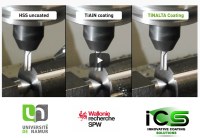TINALTA: Development of an innovative coating that extends the life of industrial cutting tools
When machining industrial parts such as gears at very high speeds, the absence of cutting fluid (for economic and ecological reasons) leads to an increase in temperature at the material/mill interface, which can reach 800 to 1000°C. In order to increase the service life of the hobs, which are repeatedly used through multiple regrinding/decoating/surface preparation/recoating operations, the cutting tool surface is covered with a very hard coating. This very thin coating, with a thickness of 1 to 5 µm (micron), must have multiple characteristics such as a high resistance to temperature, abrasion, impact, a low chemical affinity with the materials to be machined or an optimisation of chip evacuation.
The TINALTA project, obtained by Stéphane LUCAS and managed by Emile HAYE, is financed thanks to the Win²Wal programme of the SPW-EER, and involves the LARN laboratory of the Department of physics at the UNamur (NISM Institute) and the spin-off Innovative Coating Solutions (ICS). It aims at proposing a product/process pair enabling the coating of machining tools with an optimised trimetallic nitride with high performance, in particular with very high service life. This coating is currently being qualified and validated on an industrial scale. It still has to prove various indicators and pass a reliability study at high production rates.
"The coating is deposited by PVD (Physical Vapor Deposition). This vacuum deposition method is based on plasma processes," explains Emile Haye, post-doctoral researcher in charge of the project at UNamur. "A plasma is an ionised gas obtained when a voltage is applied between two surfaces in a vacuum, in the presence of a small quantity of gas. It is the same principle as neon, except that by modulating the electrical parameters, it is possible to 'spray' a source of material, which then condenses on the opposing surfaces. This method of coating synthesis has the advantage of requiring no solvents and no additional steps. The energy balance of this process is therefore low," he continues.
Among a series of constraints specific to the deposition of this coating, it is important that it can be removed. Once the tool has been used, it is re-sharpened. The coating is then removed and the surface repaired before a new coating is applied. Thus, the tool can be reused several times (up to 10-12 times). This reconditioning of industrial tools is justified for tools with high added value (hobs, gear tools), because of their very high price.
"Within the framework of the TINALTA project, we have developed an innovative process, based on PVD methods, with an original coating composition. This development was made possible by pooling the expertise of Innovative Coating Solutions (ICS), a spin-off of the University of Namur, and that of the LARN research unit of UNamur.”
An application for a European patent has just been filed and there are many prospects for future development. We can prove it to you in pictures!
https://www.youtube.com/watch?v=KTsX5bR91DQ
RS ICS (LinkedIn): https://www.linkedin.com/company/incosol4u/
Contact: Emile Haye - emile.haye@unamur.be
The project partners
- ICS spin-off: Stéphane Lucas, Noé Watiez (https://www.incosol4u.com/)
- UNamur (NISM - https://nism.unamur.be/ , LARN) : Emile Haye, Remy Wauters, Loris Chavée
Project funding: Win²Wal programme of the RW, agreement 1910092.


